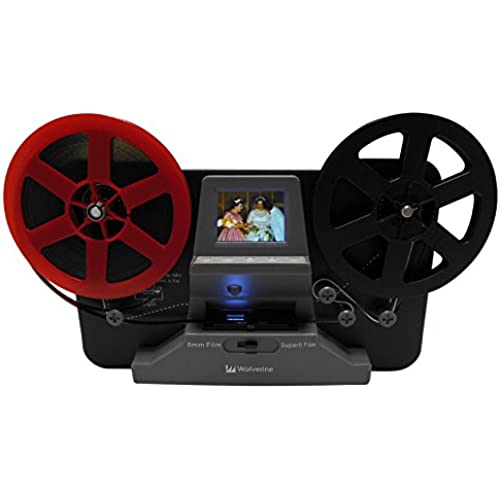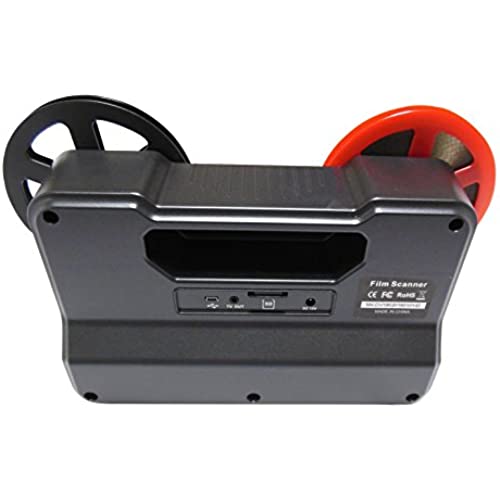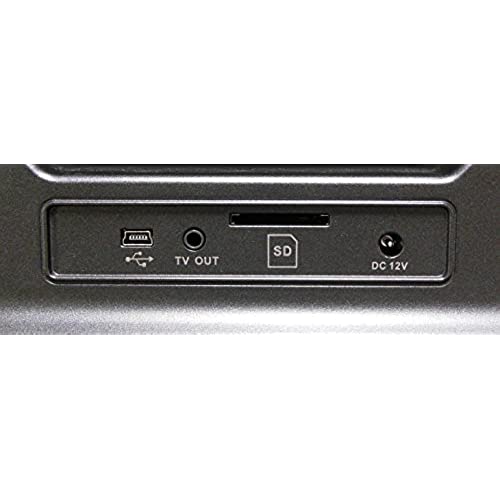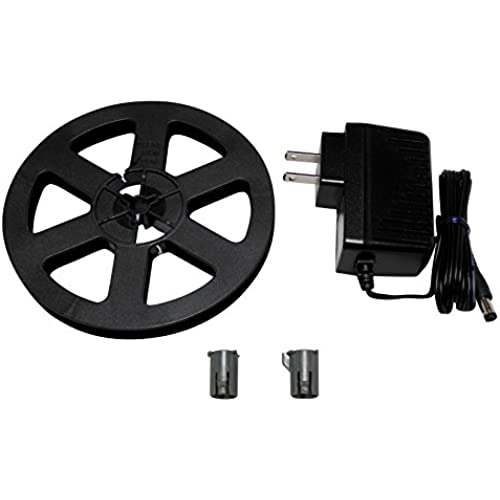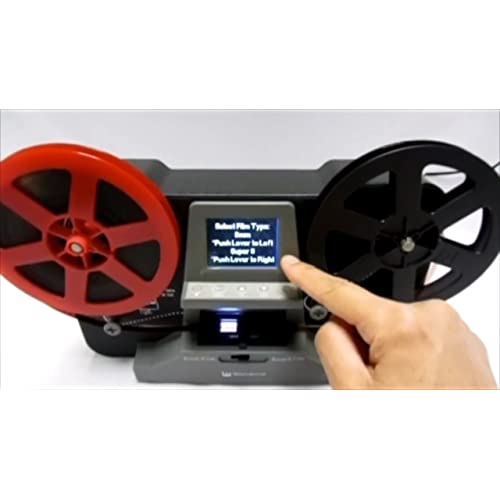Wolverine 8mm and Super 8 Film Reel Converter Scanner to Convert Film into Digital Videos. Frame by Frame Scanning to Convert 3 inch and 5 inch 8mm Super 8 Film reels into 720P Digital
-

Eric Flyer
> 24 hourI paid $275 for the Wolverine 8mm / Super8 Film-to-Digital Converter on Amazon. It is an excellent value at that price. Its not a fancy machine, but its of good quality and does the job. My father left me an assortment of Regular 8 and Super 8 films of our family from the 1950s and later. Ive been converting them to MP4 a few at a time with the Wolverine. I first clean the films with a microfiber cloth and 91% isopropyl alcohol, using my fathers old projector and take-up reel as a platform, as I hand-turn the film through the cloth dampened with alcohol. Then I back-clean the film onto the original reel using only a dry microfiber cloth. There are other cleaning products, but 91% isopropyl alcohol is incredibly cheap and it works. I also clean the Wolverine light stage before every film with the microfiber cloth and the isopropyl alcohol, which I push around with a Q-Tip. Q-Tips are linty, so I let only the cloth touch the light stage. My father had mostly 3-inch reels, but there were a few 6-inch reels, the latter all Regular 8. For those, I had to break them up into smaller reels to fit on the Wolverine. I bought some spare reels, leader tape and Presstape splices for this task. It worked fine. I have Vegas Movie Studio software to edit the converted movie files. The first thing to do is to correct the frame rate, which initially plays too fast. If you dont do this, you basically have a Keystone Kops movie. For the Regular 8 films, I stretch the length of the movie by a factor of 1.875. For Super 8, it needs to be stretched by a factor of 1.6666. The reason is that the Wolverine creates movies at 30 frames per second, while old Regular 8 movies played at 16 FPS and Super 8 at 18 FPS. Theres a little arithmetic involved, and I employ a calculator. Then I use my Vegas Movie Studio to correct the color, which is usually too yellow due to the aging film. And I generally increase the contrast slightly. Im sure that other brands of movie-editing software will also handle these tasks. While Im hand cleaning the films, I note if there are any bad distorted splices that would get stuck in the gate of the Wolverine. If there are, I babysit the film as it runs through the machine. If there are only smooth splices, I feel confident about walking away. I write down the time when the conversion started, and come back before its done. Sometimes the end of the film is stuck in the reel, and I want to yank it out, so as to not miss any frames at the end. Regular 8 films nominally take 33 minutes and 20 seconds to convert. Super 8 films take 30 minutes. But these times can vary, as the length of film on a spool is not always 50 feet exactly. You have to swap reels on the Wolverine to rewind, but Ive never had any problem with this. Overall, Im very happy with the Wolverine film converter. If you have many reels larger then 5 inches, you may wish to buy a more expensive Wolverine model that handles 7-inch reels. I think it costs about $430.
-

Robert Joseph Vito
> 24 hourI used the Wolverine scanner to digitize about 120 fifty foot rolls of 8mm film. After reading the reviews, I wasn’t sure if the scanner would last very long, so the first time through, I didn’t pay much attention to any of the adjustments such as frame position. I rushed to get through all of the films before the machine would break. However, I had no issues with the durability of the scanner, so I decided to rescan all of the films a second time, paying close attention to the adjustable parameters. The counter now reads over 780 and the scanner is still going strong. This is what I like about the scanner: • It is a frame by frame scan. • The quality of the scan is better than using a video camera to record a film projection from a screen or a piece of white paper. • It doesn’t require a lot of babysitting. The things I don’t like about the scanner: • The quality of the scan is not adjustable and needs to be improved. The video file suffers from excessive compression. • Splices need to be clean, otherwise the film will get stuck in the scanner. • The film is pulled forward by a claw, so if the sprocket holes are damaged, the film will stop. Use splice tape to fix broken film. • No two films are exactly alike. Some films are wider than others and can get stuck in the scanner. This occurred on ten percent of my films. • The worst problem I had with the scanner is jitter. This is where the frame position changes as the video progresses, making the resulting video jumpy. Most of my films had light jitter. This didn’t make them unwatchable, but it was noticeable. A small number of my films suffered from severe jitter. This made the videos completely unwatchable. Once severe jitter started, it didn’t go away until I discovered the solution described below. I found three solutions for light jitter: 1. The film on the source reel sometimes needs to be kept slightly unwound so that it is loose. As the machine pulls the film forward to scan, it only pulls the small section of loose film rather than the entire weight of the source reel. This helps to keep each frame in the same position as it scans because the machine doesn’t have to overcome the momentum of the entire source reel. This requires babysitting and is not a cure-all. 2. The two screws that attach the metal bracket to the underside of the film door may need to be loosened or tightened in order to hold the film in the proper position. 3. Deshaker software can be used on the digitized file. This does reduce jitter, but the disadvantage is that the video file needs to be recompressed, so there may be quality loss. Severe jitter was very difficult to correct. None of the solutions for light jitter worked. A second machine did not work. However, a new SD card did work. Unfortunately, severe jitter would return even with the new SD card after scanning a number of films. Replacing the SD card again would fix it. Overall, I am happy with this machine. It does a better job at a lower price than any of the other methods I have tried. The one item on my wish list that I would be willing to pay a higher price for is adjustable quality.
-

Sherry D.
> 24 hourPicture quality can be good, but greatly depends upon how well one can learn without assistance and how much patience one possesses. This unit lacks some basic features, and instructions are either less than clear or missing altogether. (Yes, instructions are included, but are incomplete and not very useful.) The way one must load the film 1) requires the user to handle the film too much and awkwardly, 2) requires the user to handle very delicate parts of the machine in a very small space, and in a way which incites breakage, and 3) affords too much probability the user will touch a glass cover which could cause cloudy or less-than-clear area(s) of the final product. A person with large hands would have a GREAT deal of difficulty, if they could do it at all. Frame adjustments are cumbersome and are made even more so because of the inability to back up the film and the lack of automatic film loading: after adjusting the frame width, x & y axis, film must be removed from the film feed completely, manually rewound and then re-loaded. For the price, this machine feels cheaply made (not made too last), is VERY quirky, lacks user-friendly intuitive controls, lacks an automatic film loading & is missing clear basic instructions. Unfortunately, Ive not seen any competitive units and certainly not in the price range I believe this unit should be. All the different (and even some of the more expensive) units are truly the exact same as this unit with a different name tag, typical of the Amazon throw-away accounts. Because of the description I have given, I believe this unit should be in the $50-75 range. The updated version may (or may not) have all (or some) of the features I felt were needed in this model, but I feel the price difference Ive seen listed is unwarranted (upwards of double to even triple this units price). Though the price may suggest it may be, I feel THIS UNIT IS NOT FOR PROFESSIONALS; its too flimsy for daily use. I also feel it is TOO COSTLY FOR HOME USE because it is basically going to be used to transfer film once. However, for those of us who can-do, the price of having film digitized by someone else can also be prohibitive. So, even though this units is quirky and lacking, with LOTS of common sense and patience (+ trial & error at first), the job can be done with satisfactory picture quality (depending on the film, too). BTW, most 8 mm and Super-8 film will record a little fast, therefore be sure to have (or get) a program which will edit mp4 files. Also, an SD card is REQUIRED to even keep the unit on, so be sure to have one (32 GB or less only). Otherwise you will receive an error message and then the unit will shut down. Ohmmmmmmmmmm...
-

fmt_doggs
> 24 hourI waited until I had digitized 100 movies before writing this review. A couple of months ago we inherited about 6000 feet spread over 80 spools of 8mm movies shot in the 1930s and 1940s. Later we were given another 20 super-8 spools from the 70s. My first thought was to get these professionally digitized, but even the cheapest service was going to be several hundred dollars and probably a lot more so I instead looked into doing it myself. I tend to buy good equipment, and was looking for prosumer level options, but found very little out there. Basically there was this unit, and the next cheapest choices was $1200 and it only did super-8. The unit itself feel pretty cheap, and I was concerned that it would not last the length of my project, especially after reading some reviews on an 8mm film enthusiast website. While plastic-y and light weight, it has not missed a beat in my 100 spools. The operation is pretty simple: (1) Pop a 32 gb SD card in the back of the unit (32 GB is as large as it will take and will hold over 200 50 foot movies) (2) Using canned air, or the included puffer brush, clean the light table (3) Thread the movie using the lines printed on the unit. (4) carefully place the film under the two tabs near the light table and close the carrier (5) Push start (6) Go do something else, because this is going to be over 30 minutes for a 50 foot reel. It will automatically stop after it runs out of film but you do tend to get a few seconds of white at the end of your movie which you can ignore or edit out using software (6) Take the card to your computer and upload to youtube, or first convert to 16/18fps using software. I just directly uploaded the files to YouTube and watched them at 75 percent speed which was fine Pros: Works! Makes very acceptable quality files that upload directly to YouTube (you can first convert/edit them) Very easy to learn Stand alone, no need to connect it to a computer until you need to transfer the files For me, a solid unit that did the job at the fraction of the cost of sending them out Works with either 8mm or super-8 movies Cons: Doesnt encode sound (some super-8 had sound) 30 frame per second is not the same as the original movie, so you need to slow down the playback or convert using software Flimsy feeling, need to handle delicately This model maxes out at 200 foot movies, although they have a new unit (pro) that can do longer ones. Keep in mind though that most home movies are 50 feet. Overall would I recommend it? I recommend you do the math. Costco has the cheapest service I could find for digitizing. $19.95 for the first 150 feet then 13 cents per foot thereafter. If you only have 30 or so movies to do, and never plan to shoot anymore (lol) it might make more sense to send them out. if you have a lot of movies, this will get the job done with a nice quality result for a fairly reasonable price. One thing I do recommend though is to GET IT DONE. These movies were excellent, and I wish very much that it had been done when the shooter was still alive. These movies have been sitting in a box for decades and now people are enjoying them again. I was able to share the videos with a history group of the town he grew up in, and they really enjoy these glimpses into the past.
-

J. Wyner
> 24 hourThe reviews for this film converter are certainly mixed but I decided to give it a go. Watching videos on YouTube of how to use the machine certainly helped my experience. I have converted half a dozen 50 foot reels of 8mm film so far and only once did I stop the conversion because I had not adjusted the frame properly. Other than that, every reel has gone through the machine non-stop. The overall quality is very good. Not like todays digital photography or VHS tapes you might have around, but good for film that in my case is up to 70 years old. Doing the conversion, however, is only the first step. To do it properly you need to edit the video, change brightness and contrast, add titles and subtitles, etc. There is plenty of editing software out there to do the job but it can get complicated. I have used Openshot which is shareware (i.e. free). Good luck to you!
-

Lodmot
> 24 hourIve never worked with Super 8 film before, so this machine introduced me to the format. Im using it to convert a bunch of old family films to digital. This machine does an amazing job-- very much on-par with what you might get if you convert it professionally at Costco, etc. It exports the film to an SD card at 960x720 resolution with a frame rate of 20 FPS, and in native 4:3 aspect ratio. I used the Wolverines built-in menu interface to adjust the framing of the picture. After its converted, Ill usually adjust the footage to 90% of the orignal speed to achieve the original 18 FPS that it was shot in (because 18 fps is 90% of 20 fps). The projector runs and captures the footage on its own, so you dont need a PC for it to convert the footage. But there is also apparently a USB port on the back of the unit, which I havent tried using yet. Im assuming that lets you hook it up to a PC if you want to do the capture on your computer. The only downside Ive noticed with this unit is that it feels a little on the plastic-y side for $300. The take-up reel is plastic (which is okay), but the spindles that the film is threaded around are stationary plastic parts too. It makes me a little concerned that it could damage/scratch the film only after a few run-throughs. I think higher quality metal spindles that rotate freely with the film would make the unit feel more high quality. Ive actually ran one of my reels through it twice in a row, and on the second transfer I spotted faint vertical black lines that were not present in the first transfer. On the other hand, Im still new with this format so I could be totally incorrect. But overall this is a really nice device, and it will serve me well in getting all my Super 8 film converted. I highly recommend Wolverine to anyone. :)
-

Burns Fisher
> 24 hourI was actually amazed at how well this device worked converting my old 8mm (mostly regular, a couple super) films to digital. Once you get it threaded and started, for the most part it just works till you get to the end of the film. That said, Ill report the negatives that I see: -I expected it to be slow and it is. I think it takes maybe 6x as long as the film, so a 50ft reel takes maybe 1/2 hour to scan. (Not exactly measured). -Regarding the picture quality: 8mm film is not very good quality in the first place, but with the default sharpness etc this was as good as I expected if not a bit better. Difficulty to use: It is a bit of a pain to thread the film through the gate and to follow the twists and turns of the path it is supposed to use without it all popping out. However, after a few times, it goes get easier. You can adjust the horizontal and vertical registration as well as the zoom so that the movie frame fills up the full picture and does not loose top, bottom, or sides. However, to do this you have to stop the recording when there is a picture there, do the adjustment, and restart it. This starts a new mp4 file. And the vertical registration seems to change a bit (not seriously) between what you adjusted and when it is running. Once or twice the film got caught in the gate--it may have been at the 25 splice on regular 8. It makes a horrible noise (and probably tore one of the sprocket holes there) but it did stop on its own after a second or 2. Unlike an old projector, the film in front of the light did not melt! (It is a cool LED, I assume). And again, you have to restart it and that causes a new MP4 file to start. (On a Mac, Quicktime viewer can re-merge them easily although it turns them into a quicktime format instead of MP4). You have to swap reels from side to side to rewind. An inconvenience, but not horrible. My final comment: The instructions say you cant use a micro-sd card in an adapter, and they say that if you read the SD card on a Mac the scanner cant read it again. I did not find either of these to be true. All I had were micro SD cards and adapters, and that was no problem. And then I plugged the SD card into a Mac to take of the files, and the card still worked just fine. Summary: Its not a professional device and for the price I would not expect that. It does what I want reasonably well, and I consider it a good purchase.
-

John from Appleton
> 24 hourThis is one of the most amazing gadget-ty things I have ever owned. YES, there IS a $2500 device you can buy that performs this task more professionally, but I guarantee you it comes no where near achieving ten times the quality of the result. Reading other reviews, I find that buyers were not careful to know what they are buying. Before I expound on that, let me state that I am just DELIRIOUSLY happy to own this thing! Okay! Other reviewers complain as follows: It does not capture audio. It is limited to 5 inch reels. It is limited to 720p scan resolution. The files it creates play back at 30 frames per second (too fast). It only creates mp4 files which are grainy and the video runs too fast. There are many other complaints. There is nothing inherently “grainy” about mp4 files. Graininess on amateur film video is generally from an automatic gain control (AGC) circuit that is trying to compensate for the fact that you are failing to provide enough light for what you are recording. This problem is most over with respect to modern gear which simply does not require the type of illumination that was necessary in home movies and early camcorders….and of course, there is nothing about mp4 files that make them play back at a different speed. What is wrong with 720p? It still looks pretty good on our big screen TVs! Do you think there is much more to capture on a tiny frame of 8mm film? READ the sales information carefully, and none of this should surprise you, and NONE of this is really a problem when you consider that the savings on the first 10 videos you digitize will pay for the cost of this machine. I used the (recently ubiquitous) services of the most visible provider of this service. The results were fine, but I waited a few weeks and paid a lot of money. I since redid a couple of my films myself and the results were EASILY as clear and watchable. Yes, the default playback speed of the videos you create gives you a pretty fast video, but when you use the common software video players, they almost all give you an opportunity to slow it down. I recommend .6 of the recorded speed. If you burn dvds, editors such as Corel VideoStudio and most others will let you CREATE a DVD that plays back at the proper speed without needing any special tweak by the person you send it to. Reading other reviews, it sounds like this machine might not be as sturdy as a Sherman tank. I recommend you do not use it for rewinding. Just rewind by hand with the help of a pencil. Save the motor for the more important use during processing. Keep it clean. Follow the directions about keeping dust out of the little place where the frames are squared up for having their picture taken. To me, with proper use, this should last a pretty long time, and should be fixable for most little minor things that might happen. Most end users would not even need the machine once they have gotten through all of their archival videos. At that point, you can probably sell it online and recover some of your costs. The little 13 page owners manual is very well done, and obviously has ENGLISH as its primary language. Just understand that you should be very cautious and careful with this. If you do that, you will be stupendously delighted as am I. Dont try to compare it feature by feature with devices that cost a four digit number! I could go on further, but there is probably a maximum review length. Ask me questions if you like - I think there is a way you can do that! I am a big fan. John in Wisconsin
-

par64guy
> 24 hourI had over 30 three minute reels of super8 movies to transfer, so I figured I would try this device. The setup was relatively straight-forward. The required adaptors made it a bit cumbersome to set up the reels. Once the film was dialed in using the frame adjust and exposure options, the output appeared to be decent quality. My biggest complaints come from the user interface which is a bit clunky and the mechanism. For $300, I expected higher performance. The menu structure could use some improvement as a lot of time gets wasted going back and forth within the menu to get to various functions. Also, when (not if) a jam occurs, you must cancel and restart which breaks up the video into multiple files. This means you will either need some editing software to splice them together or rewind the film and pray that it runs clean the next go around. The mechanism could definitely use some improvement. The motor sounds like a cheap DC gearmotor used in toys. The film seems to jam very easily if the sprocket holes are the slightest bit worn. They should have used some supplemental drive mechanism in addition to the sprocket drive to help avoid jams. Also based on the capabilities of todays camera technology, the scan speed could be easily increased by an order of magnitude. It took the device nearly 30 minutes to scan a 3 minute reel. This would have meant 15 hours of scanning for my films. Ultimately, I opted to set my Photography camera on a tripod and use the old projector to play each film in real-time. Quality ended up being good enough and only took a couple of hours to digitize. For those without a higher end camera or only a few films to digitize, this may be a good option if the price were lower. It was just not worth the cost in the opinion of a product design engineer.
-

GeorgeS
> 24 hourIve been a film nut for ages and have shot everything from regular 8mm through 35mm movie film. Previously your options for getting your 8mm movies transferred was either aiming a projector at the wall (which gets you flicker), getting a film chain transfer done which is usually the same quality as the project it on the wall option, minus the flicker but with suboptimal color and sharpness (most film chains never updated to HD technology) and and at a significant cost, then lastly there was the cadillac option: taking it to a professional telecine house like Pro8mm and paying north of $30 for a 50 roll to be transferred. The Wolverine bridges the gap very well: it offers quality superior to a film chain at a price that pays itself back pretty fast. It wont match a top telecine facility of course, but for 8mm which doesnt have much resolution to begin with, its a pretty good deal for the dollar. What is good about the Wolverine: * Best quality for the dollar that Ive seen. Definitely better and considerably more economical than the analog SDTV film chain transfers that were the standard for years (and are still probably widely in use). * Safe film transfer in house: you never have to be nervous about your film getting lost by a carrier or by a facility. * Slow film transfer: since the machine goes frame by frame (about 1/10th of the actual running speed of the film), the risk of damage due to jamming is smaller. What I wish was different: * There should be an uncompressed file option - the MP-4 compressor can cause problems with 8mm film grain which is quite sizeable. * There should be a way to adjust exposure and the other settings during the machines operation. * Others said it but Ill say it too: the file rendering should have the option to create 16-18 fps files natively, though its a relatively easy fix for anyone who has some basic editing chops. One quick cheat for you Youtubers: modify the video via Youtubes enhancements to play at 1/2 speed (2X slow motion) - this does a good job approximating the real running speed. * Others also note the limit of 200 reels - most people had projectors that had a 400 max reel capacity. Some practical tips: * If you have an existing 8mm projector, I suggest using it to rewind the film - it will go faster and you will not strain the motor unnecessarily on the Wolverine, also you will minimize film contact. * Clean and lubricate your film for a better transfer. This has gotten difficult as Kodak no longer sells movie film cleaner and lubricant. Isopropyl alcohol is rumored to be a good substitute. * Having a splicer and rewind bench will help deal with the inevitable tears in the film that will happen. * If you have Super 8 sound the Wolverine doesnt have a sound reader. For that you will have to have a separate Super 8 sound projector through which you can run the film, record the audio, and then try to synchronize it with the Wolverine transfer. That will take some skills in adjusting the audio speed as the projector wont be running at exactly the same speed as the film transfer. You will encounter synchronization drifts from time to time which will need correction. Overall this is a good device for anyone with some basic technical chops and a respectable collection of 8mm films. Even if you choose to get your film transferred at a professional telecine facility, using this device to pre-screen your footage and have some form of backup if God forbid the film gets lost is a worthwhile investment on its own. Now if they only had a 16mm version with 1080P... but then it would probably cost twice as much :D

